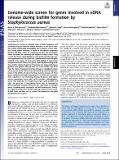Genome-wide screen for genes involved in eDNA release during biofilm formation by
Author(s)
DeFrancesco, Alicia S.; Masloboeva, Nadezda; Syed, Adnan K.; Bradshaw, Niels; Gilmore, Michael S.; Walker, Suzanne; Losick, Richard; DeLoughery, Aaron; Li, Gene-Wei; ... Show more Show less
DownloadE5969.full.pdf (1.341Mb)
PUBLISHER_POLICY
Publisher Policy
Article is made available in accordance with the publisher's policy and may be subject to US copyright law. Please refer to the publisher's site for terms of use.
Terms of use
Metadata
Show full item recordAbstract
Staphylococcus aureus is a leading cause of both nosocomial and community-acquired infection. Biofilm formation at the site of infection reduces antimicrobial susceptibility and can lead to chronic infection. During biofilm formation, a subset of cells liberate cytoplasmic proteins and DNA, which are repurposed to form the extracellular matrix that binds the remaining cells together in large clusters. Using a strain that forms robust biofilms in vitro during growth under glucose supplementation, we carried out a genome-wide screen for genes involved in the release of extracellular DNA (eDNA). A high-density transposon insertion library was grown under biofilm-inducing conditions, and the relative frequency of insertions was compared between genomic DNA (gDNA) collected from cells in the biofilm and eDNA from the matrix. Transposon insertions into genes encoding functions necessary for eDNA release were identified by reduced representation in the eDNA. On direct testing, mutants of some of these genes exhibited markedly reduced levels of eDNA and a concomitant reduction in cell clustering. Among the genes with robust mutant phenotypes were gdpP, which encodes a phosphodiesterase that degrades the second messenger cyclic-di-AMP, and xdrA, the gene for a transcription factor that, as revealed by RNA-sequencing analysis, influences the expression of multiple genes, including many involved in cell wall homeostasis. Finally, we report that growth in biofilm-inducing medium lowers cyclic-di-AMP levels and does so in a manner that depends on the gdpP phosphodiesterase gene. Keywords: Staphylococcus aureus; biofilm; eDNA; cyclic-di-AMP
Date issued
2017-07Department
Massachusetts Institute of Technology. Department of BiologyJournal
Proceedings of the National Academy of Sciences
Publisher
National Academy of Sciences (U.S.)
Citation
DeFrancesco, Alicia S. et al. “Genome-Wide Screen for Genes Involved in eDNA Release During Biofilm Formation byStaphylococcus Aureus.” Proceedings of the National Academy of Sciences 114, 29 (July 2017): E5969–E5978 © 2017 National Academy of Sciences
Version: Final published version
ISSN
0027-8424
1091-6490